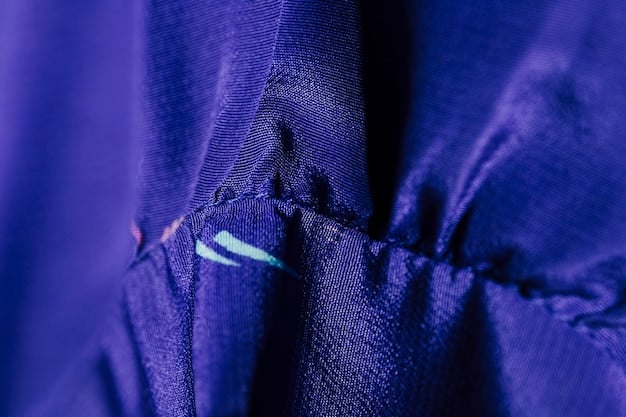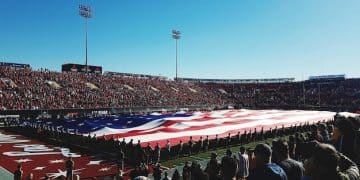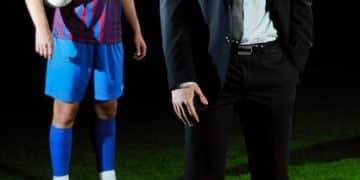Is Your US Soccer Jersey Authentic? Spotting Fakes & Protecting Investment

Verifying the authenticity of a US soccer jersey is crucial for fans to protect their investment and ensure they are supporting legitimate merchandise, involving careful inspection of tags, stitching, logos, and overall quality to differentiate genuine items from widespread counterfeits.
In the vibrant world of football fandom, owning an authentic US National Team jersey is more than just wearing a piece of fabric; it’s a statement of loyalty, identity, and passion. However, the market is flooded with counterfeit jerseys, making it challenging for fans to distinguish genuine articles from imposters. So, is your US soccer jersey authentic? Spotting fakes and protecting your investment against deceptive practices requires a keen eye and informed knowledge.
The Lure of the Authentic Jersey: More Than Just Fabric
An authentic US soccer jersey represents a tangible connection to the team, its history, and the collective spirit of millions of fans. It’s a symbol of pride, worn during triumphs and tribulations, embodying the dreams of a nation on the pitch. Beyond emotional ties, genuine jerseys offer superior quality, durability, and comfort, designed to meet the rigorous standards of professional athletes and dedicated supporters alike.
The quest for an authentic jersey is often driven by a desire for quality and a rejection of the inferior materials and unethical labor practices often associated with counterfeits. When you purchase an official product, you’re not just buying a jersey; you’re investing in the integrity of your fandom and supporting the systems that fuel the sport. This dedication to authenticity reinforces a positive cycle, where fan support contributes directly to the development of the team and the sport’s infrastructure.
Understanding what makes a jersey authentic, from the intricate details of its design to the advanced materials used in its construction, empowers fans to make informed decisions. It transforms a simple purchase into an act of knowledgeable devotion. The distinction between real and fake extends beyond mere appearance, delving into the very essence of sustainability and ethical consumption within the sports merchandise industry.
Ultimately, wearing an authentic jersey signifies belonging to a community that values quality, trust, and genuine passion. It’s about respecting the craft, the players, and the collective identity that the US National Team represents. This collective appreciation for authenticity strengthens the bond between fans and the game, ensuring that every roar from the stands or cheer from the couch is backed by a true symbol of support.
Understanding the Counterfeit Market: A Global Challenge
The global counterfeit market is a sprawling, multi-billion-dollar enterprise that thrives on exploiting popular brands and consumer demand. Soccer jerseys, particularly those of highly recognized teams like the US National Team, are prime targets due to their widespread appeal and high retail prices. Counterfeiters leverage sophisticated networks to produce vast quantities of fake merchandise, often with startling speed, making it a constant battle for brands to protect their intellectual property and for consumers to avoid being scammed.
These operations range from small-scale, backyard productions to large, organized syndicates that mimic legitimate manufacturing processes. The fake jerseys are then distributed through various channels, including online marketplaces, street vendors, and even seemingly legitimate storefronts, often at prices significantly lower than authentic products. This price disparity is a major draw for unsuspecting buyers, who might prioritize cost savings over authenticity, unaware of the implications of their purchase.
The Impact of Counterfeits
- Economic Loss: Counterfeiting results in significant revenue losses for legitimate brands and retailers, impacting their ability to invest in research, development, and marketing.
- Brand Erosion: Substandard fake products can damage a brand’s reputation, as consumers may associate poor quality with the official product.
- Unethical Practices: Counterfeit operations often rely on exploitative labor practices, including child labor and unsafe working conditions, without adhering to environmental standards.
- Fan Disappointment: Buyers are left with an inferior product that may quickly degrade, failing to live up to the expectations of an authentic jersey.
The challenge for consumers lies in the increasing sophistication of fake products. Many counterfeiters are becoming adept at replicating visual cues, making it harder for the untrained eye to spot differences. This makes it crucial for fans to be well-informed and vigilant when making a purchase. Recognizing the scale and nature of the counterfeit market is the first step in arming yourself against it.
The Devil is in the Details: Key Authentication Points to Check
Authenticating a US soccer jersey requires a meticulous inspection of several key elements, as counterfeiters often overlook or poorly replicate minute details. Paying close attention to these specific points can significantly increase your chances of discerning a genuine article from a fake.
Official Tags and Labels
Genuine jerseys come with a host of specific tags and labels. Look for holographic tags, often with unique serial numbers, that are difficult to counterfeit accurately. Nike and Adidas (the primary manufacturers for US Soccer jerseys) use distinct tag designs that include product codes, size information, and care instructions. These tags should be precisely printed, firmly attached, and free from misspellings or smudged ink. Compare the font and spacing to images of authentic tags available on official websites or trusted retailer sites.
- Hologram Inspection: Authentic jerseys often feature a specific hologram heat-pressed onto a tag. This hologram will change appearance or show different images when viewed from various angles.
- Barcode and SKU: An authentic jersey will have a scannable barcode and a SKU (Stock Keeping Unit) that corresponds to the product. You can often cross-reference this SKU on the manufacturer’s official website.
- Internal Labels: Inside the jersey, there should be multiple labels indicating material composition, country of manufacture, and care instructions. These labels should also be consistently printed, with correct grammar and spelling.
The stitching on these labels is also a critical indicator; official tags are usually stitched with precision, often with unique thread colors or patterns that are hard for fakers to perfectly replicate. Sloppy or uneven stitching on tags is a definite red flag.
Quality of Fabric and Stitching
Authentic jerseys are made from high-performance, moisture-wicking fabrics engineered for athletic performance, such as Nike’s Dri-FIT or Adidas’s AeroReady. These materials feel soft yet durable, breathable, and have a distinct texture. Counterfeit fabrics often feel cheaper, rougher, or too thin, and may lack the necessary moisture-wicking properties.
Examine the stitching throughout the jersey. Authentic jerseys feature consistently neat, tight, and even stitching without loose threads, frayed edges, or misaligned seams. Pay particular attention to:
- Seams: All seams should be smooth and lie flat against the fabric, indicating careful construction.
- Embroidered Logos: Club crests, manufacturer logos (like Nike swoosh or Adidas trefoil), and national flag emblems are often embroidered. On authentic jerseys, the embroidery will be dense, clean, and precisely detailed, with no loose loops or unevenness.
- Heat-Pressed Elements: Some logos, names, and numbers are heat-pressed onto the jersey. These should be crisp, lay flat without bubbling or peeling, and have sharp, defined edges. Fakes often have brittle or poorly applied heat-pressed elements that crack or peel easily.
The overall feel and drape of the fabric, combined with the precision of the stitching, offer significant clues. Authentic jerseys have a certain weight and fluidity that counterfeits struggle to mimic due to inferior materials and production techniques.

Logos, Badges, and Patches
The devil truly is in the details when inspecting logos and badges. Official US Soccer jerseys feature specific branding, including the US Soccer crest, the manufacturer’s logo, and potentially league or tournament patches. Each of these elements has a distinct design, color, and application method that counterfeiters often get wrong.
The US Soccer crest, whether embroidered or heat-pressed, should be geometrically perfect, with crisp lines and accurate colors. Examine the stars, stripes, and ball within the crest for any deformities or misalignments. The manufacturer’s logo (e.g., Nike’s swoosh) should also be perfectly proportioned and applied. Fakes often have slight variations in shape, size, or angle that betray their inauthenticity.
Authentic patches, such as those for the World Cup or specific tournaments, are highly detailed and often have a tactile quality. They are usually heat-pressed with precision, adhering smoothly to the fabric. Compare them side-by-side with official images if possible. Counterfeits may have unevenly printed patches, blurred details, or patches that seem loosely affixed or prone to peeling.
Additionally, check for consistency in color and material used for all badges and logos across the jersey. Authentic items maintain strict color codes and material standards, while fakes might show slight color variations or use cheaper, shinier threads that don’t match the original design intent. These subtle discrepancies are often the most telling signs of a fraudulent product.
Where to Buy: The Safest Routes for Authentic Jerseys
The source of your purchase is arguably the most critical factor in ensuring you acquire an authentic US soccer jersey. Avoiding risky channels significantly reduces your exposure to counterfeit products. Trusting established and reputable vendors is paramount to protecting your investment.
Official Retailers and Brand Websites
The safest place to buy an authentic US soccer jersey is directly from the official manufacturer’s website (e.g., Nike.com or Adidas.com) or the official US Soccer Store online. These sources guarantee that you are purchasing a genuine product straight from the source, eliminating the risk of counterfeits. They also offer direct customer support for any issues or concerns about your purchase.
Beyond official brand sites, major authorized sports retailers are also reliable options. These include large chain stores like Dick’s Sporting Goods, Fanatics, and licensed football specialty shops. These retailers have direct agreements with manufacturers and undergo strict verification processes to ensure the authenticity of their merchandise. Look for “authorized dealer” badges or information on their websites.
Beware of Unofficial Marketplaces and Unverified Sellers
Online marketplaces like eBay, Amazon (especially third-party sellers), and social media selling groups are hotbeds for counterfeit goods. While some legitimate sellers do operate on these platforms, the sheer volume of fake products makes it incredibly risky. If you choose to buy from these sites, exercise extreme caution and scrutinize seller reviews, ratings, and return policies.
- Check Seller History: Look for a long history of positive reviews, specifically regarding sports memorabilia or jerseys. New sellers with suspiciously low prices should be avoided.
- Examine Product Photos: Be wary of sellers who use generic stock photos. Request actual photos of the item, including close-ups of tags, stitching, and logos.
- Pricing Red Flags: If an offer seems too good to be true, it almost certainly is. Authentic jerseys command a certain price point; heavily discounted “new” jerseys are often fakes.
- Returns and Refunds: Legitimate sellers will have clear return policies. Counterfeiters often avoid offering returns or make the process deliberately difficult.
Local flea markets, street vendors, and unverified pop-up shops are almost always sources of counterfeit products. While the low prices can be tempting, the quality and authenticity are rarely legitimate. Stick to environments where the authenticity of the product can be verified and guaranteed.
Post-Purchase Verification: What to Do After Buying
Even after making a purchase from what you believe is a reputable source, a final layer of verification can provide peace of mind. Immediate post-purchase checks allow you to confirm authenticity and take action if you suspect you’ve received a counterfeit without delay.
Upon receiving the jersey, perform a detailed visual inspection using all the authentication tips discussed previously: examine the tags, stitching, fabric quality, and logo precision. Compare the new jersey against images of known authentic jerseys found on official manufacturer or team websites. Pay close attention to subtle details that may have been missed during the online viewing process or in a quick store inspection.
If your jersey includes a unique product code, such as a QR code or a numerical serial, attempt to verify it through the manufacturer’s official online verification tool, if one is available. Some major brands have systems in place that allow you to enter these codes to confirm the authenticity of the product.

Another strong indicator is the packaging. Authentic jerseys often come in branded bags or boxes with specific labels and tags that match the product inside. Counterfeit packaging is usually generic, flimsy, or features design inconsistencies.
What to Do if You Suspect a Fake
- Document Everything: Take clear photos of the jersey, focusing on the details that indicate it might be a fake (poor stitching, incorrect logos, flimsy fabric, suspicious tags). Keep records of your purchase, including receipts, transaction IDs, and communication with the seller.
- Contact the Seller: Immediately contact the seller with your concerns. Clearly state why you believe the item is inauthentic and request a refund or exchange. Reference their return policy.
- File a Dispute: If the seller is unresponsive or uncooperative, file a dispute with the payment provider (e.g., credit card company, PayPal) or the platform where you made the purchase (e.g., eBay, Amazon). Provide all your documentation as evidence.
- Report to Authorities: Consider reporting the counterfeit to the brand itself (Nike, Adidas) or to consumer protection agencies. While it may not directly lead to your refund, it helps the brand combat counterfeiting and protects other consumers.
Acting quickly and systematically increases your chances of resolving the issue successfully. Being an informed consumer not only protects your own purchase but also contributes to the broader effort of combating the illegal counterfeit trade.
Maintaining Your Authentic Jersey: Protecting Your Investment for Years
Once you’ve successfully acquired an authentic US soccer jersey, proper care and maintenance are crucial to prolong its life, preserve its quality, and ultimately protect your investment. Authentic jerseys are made from advanced materials that require specific care to maintain their performance characteristics and aesthetic appeal.
Washing and Drying Guidelines
Always follow the care instructions on the jersey’s internal labels. Generally, for athletic wear, this means:
- Wash Cold: Use cold water to prevent shrinking, fading, and damage to heat-pressed elements.
- Inside Out: Turn the jersey inside out before washing to protect logos, numbers, and patches from abrasion.
- Gentle Cycle: Use a delicate or gentle cycle on your washing machine.
- Mild Detergent: Avoid harsh detergents, bleach, or fabric softeners, as these can degrade the fabric’s technical properties and damage applied graphics.
- Air Dry: Line dry or lay flat to dry. Avoid using a tumble dryer, as high heat can cause shrinking, crack heat-pressed graphics, and damage the fabric. If you must use a dryer, set it to a very low heat or air-only cycle.
Washing your jersey alone or with similar colors can also prevent color bleeding and lint transfer. For heavily soiled jerseys, consider pre-treating stains carefully, avoiding harsh scrubbing directly on logos.
Storage and Handling
Proper storage is essential to keep your jersey in pristine condition. Store your jersey in a cool, dry place away from direct sunlight, which can cause fading. Hanging the jersey on a padded hanger is preferable to folding, especially for match-worn or signed jerseys, as folding can create permanent creases or damage graphics over time.
If you’re storing the jersey for an extended period, consider using a garment bag to protect it from dust and environmental factors. Avoid storing jerseys in plastic bags for long durations, as this can trap moisture and lead to mildew or degradation of the fabric.
When handling your jersey, particularly when putting it on or taking it off, be gentle to avoid stretching the fabric or straining the seams. Try to avoid excessive stretching of the collar or sleeves, especially if they have tight elastic bands.
By following these simple care instructions, your authentic US soccer jersey will remain a proud symbol of your support for years to come, looking as good as the day you first purchased it. This diligence not only preserves the jersey but also honors the craftsmanship and innovation behind its creation.
The Ethical Dimension: Why Choosing Authentic Matters
Beyond personal investment, opting for an authentic US soccer jersey carries significant ethical implications. Supporting legitimate products is not merely about quality; it’s about endorsing fair labor practices, environmental responsibility, and the continued growth and integrity of the sport itself. Choosing authenticity resonates far deeper than just the price tag or perceived quality.
Firstly, the production of counterfeit goods is often linked to unethical and illegal activities. This includes exploitative labor conditions, where workers, sometimes children, are subjected to low wages, long hours, and unsafe environments. Counterfeit factories rarely adhere to international labor laws or human rights standards. By purchasing fakes, consumers inadvertently support these egregious practices, contributing to a global system of exploitation.
Environmental and Economic Impact
- Environmental Degradation: Counterfeit operations typically disregard environmental regulations, contributing to pollution through improper waste disposal and the use of harmful chemicals.
- Economic Underperformance: The illegal trade in counterfeits diverts billions of dollars from legitimate businesses, impacting their ability to hire, innovate, and contribute to national economies through taxes and job creation.
- Funding Criminal Networks: Profits from counterfeit sales often fund organized crime, including drug trafficking, human trafficking, and even terrorism, making the fight against fakes a matter of public safety.
When you purchase an authentic jersey from an official retailer, you are choosing to support brands that are accountable for their supply chains, often investing in sustainable materials, ethical manufacturing processes, and fair wages for their workers. These companies contribute to the economy, comply with tax laws, and frequently engage in philanthropic activities, strengthening communities.
Furthermore, revenues from authentic jersey sales directly benefit the US Soccer Federation and its associated programs, from youth development to national team funding. This financial support is crucial for training facilities, coaching programs, player development, and ensuring the continued competitiveness of US soccer on the international stage. Every authentic purchase plays a part in nurturing the sport from the grassroots up.
In essence, choosing authentic is an act of consumer responsibility. It reflects a commitment to ethical consumption, a rejection of illegal commerce, and a direct investment in the future of the sport you love. It transforms a simple clothing purchase into a meaningful statement about what you value and the kind of world you wish to support.
| Key Aspect | Brief Description |
|---|---|
| 🏷️ Official Tags & Labels | Look for specific holograms, serial numbers, precise printing, and accurate spelling on all tags. |
| 🧵 Fabric & Stitching Quality | Authentic jerseys use high-performance fabric; check for neat, tight, and consistent stitching. |
| 🎽 Logos & Badges Details | Examine the US Soccer crest and manufacturer logos for perfect geometry, crisp lines, and precise application. |
| 🛍️ Purchase Source & Ethics | Buy from official retailers; choosing authentic supports ethical labor and the sport’s ecosystem. |
Frequently Asked Questions About Jersey Authenticity
▼
The most common indicators of a fake jersey include poor stitching, inferior fabric quality that feels cheap or thin, misspellings or smudged print on tags and labels, misaligned or poorly embroidered logos, and unrealistically low prices. Also, often the sizing or fit differs significantly from authentic versions.
▼
Yes, most authentication can be done with a keen eye and attention to detail. Compare the jersey to official images online, scrutinize tags, stitching, and logos for precision. While professional tools exist, a thorough manual inspection is highly effective for casual buyers identifying common counterfeits.
▼
Yes, fan versions (often called “replica” or “stadium” jerseys) are authentic products. They are officially licensed and manufactured but are designed for casual wear rather than on-pitch performance. They typically use different materials and construction than the more expensive “player” versions, but they are still genuine.
▼
The hologram tag is a crucial authentication feature. Nike, for example, uses a heat-pressed jock tag with a specific serial number and a changing hologram that is difficult for counterfeiters to replicate accurately. Its presence and correct appearance are strong indicators of authenticity.
▼
First, gather all documentation of your purchase and evidence of the jersey’s inauthenticity. Contact the seller immediately for a refund. If unsuccessful, file a dispute with your credit card company or payment platform. Reporting the incident to the brand and consumer protection agencies is also advisable to help curb counterfeiting.
Conclusion
In the expansive and often deceptive market of sports merchandise, discerning an authentic US soccer jersey from a counterfeit is a critical skill for any dedicated fan. Beyond the aesthetic appeal, choosing genuine products ensures superior quality, directly supports the growth of the sport, and upholds ethical production standards. By meticulously examining tags, fabric, stitching, and logos, and by prioritizing purchases from official and authorized retailers, fans can confidently protect their investment and wear their support with genuine pride. Your informed decision not only safeguards your own passion but also contributes meaningfully to the integrity of the game for all.





